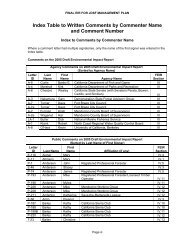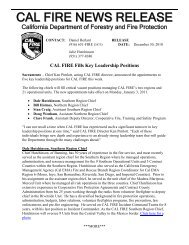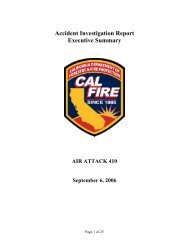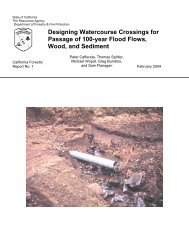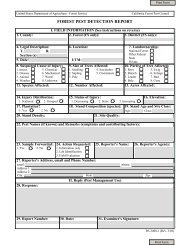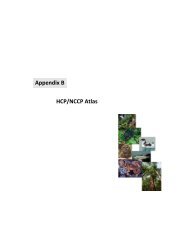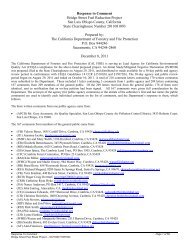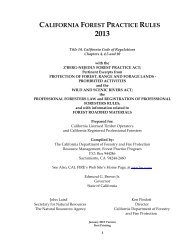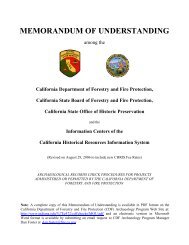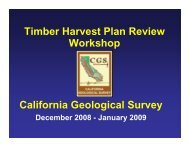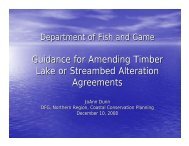Boggs Mountain Demonstration State Forest Draft ... - Cal Fire
Boggs Mountain Demonstration State Forest Draft ... - Cal Fire
Boggs Mountain Demonstration State Forest Draft ... - Cal Fire
You also want an ePaper? Increase the reach of your titles
YUMPU automatically turns print PDFs into web optimized ePapers that Google loves.
<strong>Boggs</strong> <strong>Mountain</strong> <strong>Demonstration</strong> <strong>State</strong> <strong>Forest</strong> <strong>Draft</strong> Management Plan, June 2008<br />
cutbank to approximately 8 feet from the outboard edge of the road or landing. Fill thickness<br />
should grade down to not more than 3 feet along the outboard edge of the road to minimize the<br />
potential for mass movement. The fill shall be shaped conformably into the existing cutbank, not<br />
to exceed the height of the cutbank. The steepness of any finished fillsite shall not exceed 50%.<br />
The finished surface shall not trap or pond surface water and must encourage surface flow in the<br />
same direction as adjacent lands.<br />
8. Straw Mulching<br />
Straw from bales shall be spread evenly over a predesignated area at an application rate of 3000<br />
to 6000 lbs./acre, as specified in the field. At these application rates, the ground surface will be<br />
visible in no more than 5% of the mulched area. Covered areas should be 3 to 4 inches deep.<br />
• Straw shall be spread evenly at the designated rate and within the designated bare<br />
and/or disturbed areas.<br />
• Bailing wire shall be removed from the site and disposed of properly.<br />
• Straw shall be as free as possible from exotic seeds. Hay shall not be used unless<br />
otherwise specified.<br />
• Mulching shall be the last task performed on the work area, following any heavy<br />
equipment operations, seeding and fertilizer application.<br />
Heavy Equipment<br />
1. Bulldozers<br />
Bulldozers are best for moving large quantities of fill quickly, preliminary stream crossing<br />
excavations, rolling dips, recontouring rock pits and for final shaping of outsloped roads, landings<br />
and fillsites.<br />
2. Excavators<br />
Excavators are best for lifting fill on steep slopes, final shaping of stream channel bottoms and<br />
working in tight locations, such as between trees. Excavators have a 360-degree swing, enabling<br />
them to put the fill directly behind them, where another piece of equipment can get to it.<br />
3. Backhoes<br />
Backhoes are seldom used for excavating work, except for road maintenance activities such<br />
as replacing culverts. Their limited swing and reach, and low bucket capacity make them<br />
inefficient for large excavation sites. The major advantage of a backhoe is mobility and lowcost<br />
on small work sites.<br />
4. Dump Trucks<br />
Dump trucks are a costly but essential method to move fill longer distances. If fill needs to be<br />
moved further than 800 feet, trucks are usually more cost-effective than bulldozers. The use<br />
of 10 cubic-yard trucks is very common.<br />
61



